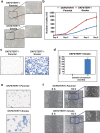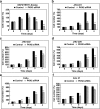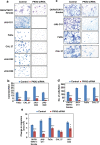Role of protein kinase N2 (PKN2) in cigarette smoke-mediated oncogenic transformation of oral cells
- PMID: 29480433
- PMCID: PMC6235782
- DOI: 10.1007/s12079-017-0442-2
Role of protein kinase N2 (PKN2) in cigarette smoke-mediated oncogenic transformation of oral cells
Abstract
Smoking is the leading cause of preventable death worldwide. Though cigarette smoke is an established cause of head and neck cancer (including oral cancer), molecular alterations associated with chronic cigarette smoke exposure are poorly studied. To understand the signaling alterations induced by chronic exposure to cigarette smoke, we developed a cell line model by exposing normal oral keratinocytes to cigarette smoke for a period of 12 months. Chronic exposure to cigarette smoke resulted in increased cellular proliferation and invasive ability of oral keratinocytes. Proteomic and phosphoproteomic analyses showed dysregulation of several proteins involved in cellular movement and cytoskeletal reorganization in smoke exposed cells. We observed overexpression and hyperphosphorylation of protein kinase N2 (PKN2) in smoke exposed cells as well as in a panel of head and neck cancer cell lines established from smokers. Silencing of PKN2 resulted in decreased colony formation, invasion and migration in both smoke exposed cells and head and neck cancer cell lines. Our results indicate that PKN2 plays an important role in oncogenic transformation of oral keratinocytes in response to cigarette smoke. The current study provides evidence that PKN2 can act as a potential therapeutic target in head and neck squamous cell carcinoma, especially in patients with a history of smoking.
Keywords: Carcinogenesis; Cell adhesion; High-throughput; Orbitrap fusion; Smoking.
Conflict of interest statement
The authors declare that no competing financial interests exist.
Figures





Similar articles
-
Early effects of cigarette smoke extract on human oral keratinocytes and carcinogenesis in head and neck squamous cell carcinoma.Head Neck. 2020 Sep;42(9):2348-2354. doi: 10.1002/hed.26247. Epub 2020 May 21. Head Neck. 2020. PMID: 32437034 Free PMC article.
-
Chronic exposure to chewing tobacco selects for overexpression of stearoyl-CoA desaturase in normal oral keratinocytes.Cancer Biol Ther. 2015;16(11):1593-603. doi: 10.1080/15384047.2015.1078022. Epub 2015 Sep 21. Cancer Biol Ther. 2015. PMID: 26391970 Free PMC article.
-
Molecular alterations associated with chronic exposure to cigarette smoke and chewing tobacco in normal oral keratinocytes.Cancer Biol Ther. 2018;19(9):773-785. doi: 10.1080/15384047.2018.1470724. Epub 2018 May 29. Cancer Biol Ther. 2018. PMID: 29723088 Free PMC article.
-
The potential roles of cigarette smoke-induced extracellular vesicles in oral leukoplakia.Eur J Med Res. 2023 Jul 22;28(1):250. doi: 10.1186/s40001-023-01217-0. Eur J Med Res. 2023. PMID: 37481562 Free PMC article. Review.
-
Decoding Oral Carcinogenesis and Tumor Progression in Whole Cigarette Smoke Exposure: A Systematic Review.Cureus. 2024 Aug 15;16(8):e66966. doi: 10.7759/cureus.66966. eCollection 2024 Aug. Cureus. 2024. PMID: 39280415 Free PMC article. Review.
Cited by
-
circ_SEPT9, a newly identified circular RNA, promotes oral squamous cell carcinoma progression through miR-1225/PKN2 axis.J Cell Mol Med. 2020 Nov;24(22):13266-13277. doi: 10.1111/jcmm.15943. Epub 2020 Oct 14. J Cell Mol Med. 2020. PMID: 33090705 Free PMC article.
-
How to Achieve Therapeutic Response in Erlotinib-Resistant Head and Neck Squamous Cell Carcinoma? New Insights from Stable Isotope Labeling with Amino Acids in Cell Culture-Based Quantitative Tyrosine Phosphoproteomics.OMICS. 2021 Sep;25(9):605-616. doi: 10.1089/omi.2021.0057. Epub 2021 Aug 24. OMICS. 2021. PMID: 34432535 Free PMC article.
-
The structure and function of protein kinase C-related kinases (PRKs).Biochem Soc Trans. 2021 Feb 26;49(1):217-235. doi: 10.1042/BST20200466. Biochem Soc Trans. 2021. PMID: 33522581 Free PMC article. Review.
-
LINC00668 cooperated with HuR dependent upregulation of PKN2 to facilitate gastric cancer metastasis.Cancer Biol Ther. 2021 Apr 3;22(4):311-323. doi: 10.1080/15384047.2021.1905138. Epub 2021 Apr 20. Cancer Biol Ther. 2021. PMID: 33879018 Free PMC article.
-
Chronic shisha exposure alters phosphoproteome of oral keratinocytes.J Cell Commun Signal. 2019 Sep;13(3):281-289. doi: 10.1007/s12079-019-00528-4. Epub 2019 Jul 19. J Cell Commun Signal. 2019. PMID: 31321732 Free PMC article.
References
Grants and funding
LinkOut - more resources
Full Text Sources
Other Literature Sources
Molecular Biology Databases
Research Materials

